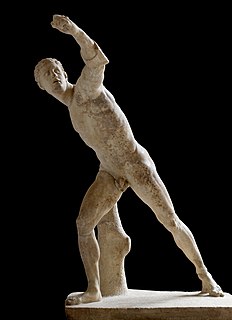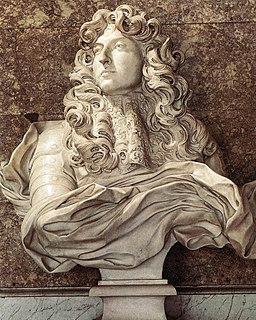 W
WThe Arles bust is a life-sized marble bust of a man, possibly Julius Caesar, dating to around the 1st century BC. It is part of the collection of the Musée de l'Arles antique.
 W
WThe Borghese Gladiator is a Hellenistic life-size marble sculpture portraying a swordsman, created at Ephesus about 100 BC, now on display at the Louvre.
 W
WThe Bust of Cardinal Escoubleau de Sourdis is a marble portrait sculpture by the Italian artist Gian Lorenzo Bernini. Executed in 1622, the work depicts François de Sourdis. It is currently in the Musée d'Aquitaine in Bordeaux, France.
 W
WThe Bust of Cardinal Richelieu is a marble sculpture by the Italian sculptor Gian Lorenzo Bernini, situated at the Louvre in Paris.
 W
WThe Bust of Louis XIV is a marble portrait by the Italian artist Gian Lorenzo Bernini. It was created in the year 1665 during Bernini's visit to Paris. This sculptural portrait of Louis XIV of France has been called the "grandest piece of portraiture of the baroque age". The bust is on display at the Versailles Palace, in the Salon de Diane in the King's Grand Apartment.
 W
WBust of Mary Cathcart is a stone bust by Marie-Anne Collot, sculpted between 1768 and 1772. She produced several versions of it - the plaster original of 1768 is in the Louvre, a completed marble version is in the Russian Museum and an incomplete marble version in the Musée des Beaux-Arts de Nancy.
 W
WThe Head of Arles, formerly known also as the Head of Livia or the Head with the broken nose is a fragment of a Roman marble statue in two parts, of which only the bust remains, which probably depicts Venus (Aphrodite) and was discovered in the ruins of the Ancient Theatre of Arles in 1823 during the removal of accreted material from the theatre. The Head of Arles represents an iconographic type called Aspremont-Lynden/Arles. It is now part of the permanent exhibition of the Musée de l'Arles et de la Provence antiques with the inventory number FAN.92.00.405.
 W
WThe Kore of Lyons is a Greek statue of Pentelic marble depicting a bust of a young girl of the kore type, conserved at the musée des beaux-arts de Lyon, France. Deriving from the Athenian Acropolis, it is generally dated to the 540s BC. Considered the centrepiece of the museum's antiquities department, the statue was acquired between 1808 and 1810.
 W
WMarcellus as Hermes Logios, sculpture of Marcellus the Younger as Hermes Logios, the god of eloquence. It was executed in marble circa 20 BC, and was signed by Cleomenes the Athenian.
 W
WThe Marly Horses are two 1743–1745 Carrara marble sculpted groups by Guillaume Coustou, showing two rearing horses with their groom. They were commissioned by Louis XV of France for the trough at the entrance to the grounds of his château de Marly. Coustou's last works, they were intended to replace two other sculpted groups, Mercury on Pegasus and Pegasus, Renown of Horses, both by Antoine Coysevox, which had been removed to the Tuileries Gardens in 1719.
 W
WThe Praetorians Relief is a Roman marble relief dated to c. 51–52 AD and housed in the Louvre-Lens.
 W
WThe Rebellious Slave is a 2.15m high marble statue by Michelangelo, dated to 1513. It is now held in the Louvre in Paris.
 W
WSakuntala, also known as Sakountala or Çacountala , is a sculpture by the French artist Camille Claudel, made in several versions in different media from 1886, with a marble version completed in 1905, and bronze castings made from 1905. The sculpture depicts a young couple, with a kneeling man embracing a woman leaning towards him. It was named after the play Shakuntala by the 4th-5th century Indian poet Kālidāsa, and is inspired by the moment when the title character Shakuntala is reunited with her husband Dushyanta after a long separation.
 W
WThe Statue of the Tiber river with Romulus and Remus is a large statue from ancient Rome exhibited at the Louvre museum in Paris, France. It is an allegory of the Tiber river that waters the city of Rome.
 W
WThe Venus de Milo is an ancient Greek statue and one of the most famous works of ancient Greek sculpture. Initially it was attributed to the sculptor Praxiteles, but based on an inscription that was on its plinth, the statue is now thought to be the work of Alexandros of Antioch.
 W
WThe Winged Victory of Samothrace, also called the Nike of Samothrace, is a marble Hellenistic sculpture of Nike, that was created in about the 2nd century BC. Since 1884, it has been prominently displayed at the Louvre and is one of the most celebrated sculptures in the world. H. W. Janson described it as "the greatest masterpiece of Hellenistic sculpture".